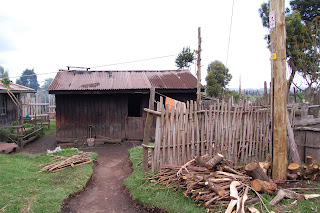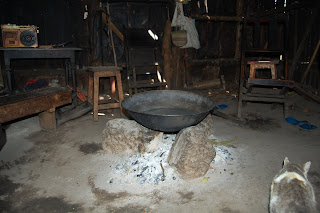
The day after we arrived in Israel, we woke up in Tel-Aviv (stayed in a family friends’ house), and drove about 45 minutes east to Jerusalem. Navigating was a bit of a struggle since road names often had multiple spellings on signs that were only a few hundred feet apart. After a few miscues, we managed to meet up with our tour guide, Peter, who hopped in the car and began leading us around.
Peter’s first question: you want the Christian, Muslim, or Jewish tour? That pretty much sums up the Middle East doesn’t it?
Our first stop was at the Mount of Olives, which affords a great view of the Old City. The Dome on the Rock is the big gold dome. The whole hill is basically covered with Jewish graves, as they believe that this is where the first people are taken into heaven.
Jerusalem from the Mount of Olives:

(the foreground is the thousands of Jewish tombs on the Mount and in the background you can see the domes of the Dome of the Rock (Muslim), the Church of the Holy Sepulcher (Christian) and most of old Jerusalem)
From a church on the Mount of Olives:

A bit further down is the Garden of Gethsemane, where Jesus was arrested the night before he was crucified. A church has been built around the rock where the arrest took place. Our tour guide informed us that this is one of the sites that has “Level 1” evidence, that is that it is regarded as the actual garden in religious tradition, and with archeological evidence.
Trees in Gesthsemane:

Church in the Garden:

We then parked and headed into the Old City. We first passed through the Muslim Quarter, which was dominated by a market made up of narrow alleys with eager vendors shouting to entice you into their shops. The smell of fresh Arabic coffee, spices, and grilling meat permeated the air. We walked through fairly quickly, as we needed to get to the sites because two days is actually not enough to thoroughly cover Jerusalem.
Walking through the narrow market with A and Koko:

Our first major stop was the Church of the Holy Sepulchre. Originally built in the Byzantine era, the church was destroyed several times, and the current church was built primarily in the 11th century by the Crusaders, though some remains of earlier churches can still be seen. It is built on the site where Jesus was crucified (Golgatha, or Calvary) and was buried. The church is actually more like six churches; the Ethiopian Orthodox, Greek Orthodox, Armenian Orthodox, Roman Catholic, Coptic Orthodox and Syrian Orthodox all maintain portions of the church, and their areas are decorated in ways typical of their respective denomination. We were able to go into the tomb where Jesus was buried, and see the rock where he was crucified.
This is the mosaic on the ceiling of the Church of the Holy Sepulcher:

We then walked through the Jewish Quarter, which is of the same style as the rest of the old town, but most of it was built since the 1960s, and then through the Armenian Quarter, to the Upper Room, where the Last Supper took place (sorry, no pics).
At this point, we were getting hungry and eager to try some new foods after 4.5 months in Kenya. So we stopped for a short lunch break of delicious hummus, falafel, grilled chicken, pita, and delicious pickled accoutrements. This gave Peter (the tourguide) ample time to hit on Koko (E’s brother’s girlfriend) after he discovered she was Jewish, which was pretty amusing. After lunch, we trekked to see the Western or Wailing Wall. Like most people, I knew that the Wailing Wall was a Jewish holy site, but didn’t really know why.
Here you can see the Wailing Wall in the foreground and the Dome of the Rock on the Temple Mount above it:

Brief explanation of a very complicated story about the Wailing Wall:
The Wailing Wall is the western wall of Herod’s temple complex, built around 2 BC. This is the traditional site where Abraham was ready to sacrifice Isaac before God stopped him. Solomon’s Temple was though to have been originally built here, though no evidence has ever been found. So, Herod built on the site, and around 200 AD, this temple was destroyed, though the outer walls remained intact. Around 700 AD, Muslims came into power in the region, and they built the Temple on the Rock at the site of Herod’s temple, as they believe that Mohammad ascended into heaven at this site as well. As you may have heard, the Jews and the Muslims don’t always see eye to eye, so Jews are not allowed into the temple complex anymore, so they can’t venerate their most holy site. All politics of Israel and Palestine aside, basically the Western Wall is the closest point that Jews can get to the rock where God spoke to Abraham (you can see this in the map above), and thus, it is the holiest site in the Jewish religion. Sorry, that wasn’t so brief, but I did my best.
The wall itself wasn’t terribly interesting, though the site of hundreds of men and women praying from the Torah and stuffing little prayers into the cracks between the rocks was interesting to see. The men in the group had to wear little disposable yarmulkes, which looked pretty funny on my big head. We didn’t have time on the first day to visit the temple complex, but visited the next day.
We saw a ton more, but I think I touched on the highlights. Before this visit, I didn’t appreciate how complicated the situation in Jerusalem, and much of the Middle East, really is. In an area no bigger than a few city blocks, are some of the holiest sites for the three major monotheistic religions, covering half of the world’s population, with many of the sites overlapping. Politics and religion cannot be separated in these areas, which has obviously caused terrible conflict for centuries. It’s hard to say what the solution is, as even within religions, people often don’t agree. Our guide told a story about how a light bulb burned out in a contested area of the Church of the Holy Sepulchre, and they had to call several meetings of the different denominations to figure out who should change it, as to change it was like laying claim to the area. Finally, a Jewish man was called to “check the light”, and it was magically fixed. If people of the same religion can't decide on a lightbulb, the idea of peace in the region seems quite difficult.
Anyway, for us, it was amazing to see many of the sites that play such a prominent role in the Bible. Reading the Bible has become a lot more vivid and meaningful since the visit, as I can actually picture where things took place.









































